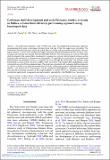Carbonate shelf development and early Paleozoic benthic diversity in Baltica : a hierarchical diversity partitioning approach using brachiopod data
Date
02/2022Metadata
Show full item recordAbstract
The Ordovician-Silurian (similar to 485-419 Ma) was a time of considerable evolutionary upheaval, encompassing both great evolutionary diversification and one of the first major mass extinctions. The Ordovician diversification coincided with global climatic cooling and paleocontinental collision, the ecological impacts of which were mediated by region-specific processes including substrate changes, biotic invasions, and tectonic movements. From the Sandbian-Katian (similar to 453 Ma) onward, an extensive carbonate shelf developed in the eastern Baltic paleobasin in response to a tectonic shift to tropical latitudes and an increase in the abundance of calcareous macroorganisms. We quantify the contributions of environmental differentiation and temporal turnover to regional diversity through the Ordovician and Silurian, using brachiopod occurrences from the more shallow-water facies belts of the eastern Baltic paleobasin, an epicontinental sea on the Baltica paleocontinent. The results are consistent with carbonate shelf development as a driver of Ordovician regional diversification, both by enhancing broadscale differentiation between shallow- and deep-marine environments and by generating heterogeneous carbonate environments that allowed increasing numbers of brachiopod genera to coexist. However, temporal turnover also contributed significantly to apparent regional diversity, particularly in the Middle-Late Ordovician.
Citation
Penny , AM , Hints , O & Kroger , B 2022 , ' Carbonate shelf development and early Paleozoic benthic diversity in Baltica : a hierarchical diversity partitioning approach using brachiopod data ' , Paleobiology , vol. 48 , no. 1 , pp. 44–64 . https://doi.org/10.1017/pab.2021.3
Publication
Paleobiology
Status
Peer reviewed
ISSN
0094-8373Type
Journal article
Description
This paper is part of the project “Ecological Engineering as a Biodiversity Driver in Deep Time,” funded by the Academy of Finland, and is a contribution to the IGCP program 653 “The Onset of the Great Ordovician Biodiversification Event.” O.H. acknowledges support from the Estonian Research Council grant PRG836.Collections
Items in the St Andrews Research Repository are protected by copyright, with all rights reserved, unless otherwise indicated.

